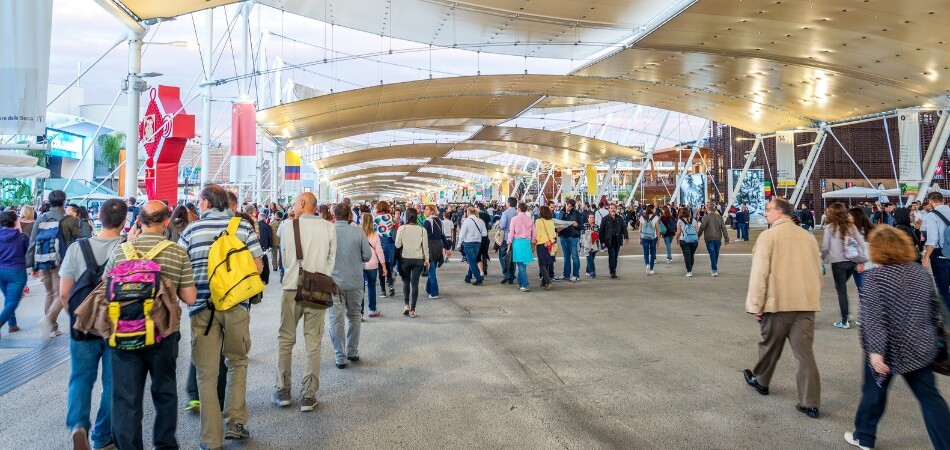Trade shows offer businesses a unique opportunity to showcase their products and services to a targeted audience. But if you’re considering participating in one, you’ve likely asked yourself a crucial question: “How much does a 20×20 trade show booth cost?”
The expense of a 20×20 trade show booth can range between $10,000 and $50,000 or even more, with significant variations. The ultimate price is influenced by factors like booth design, materials, location, and additional features.
Whether you’re a seasoned exhibitor or a first-time participant, in this blog, we’ll break down trade show booth costs. We’ll look at factors like booth design, materials, location, and extra stuff that affect the price. Knowing these costs will help you make smart choices for a successful and budget-friendly trade show experience.
The Purpose of the Trade Show Booth
The primary aim of a trade show booth is to attract visitors and engage them effectively. Through compelling design, interactive displays, and engaging content, a booth creates a lasting impression, leaving attendees curious about your offerings.

Furthermore, a well-designed booth serves as a platform to showcase your products or services, allowing attendees to see, touch, and experience them firsthand. This tangible interaction can significantly influence potential customers’ perceptions and decisions.
Additionally, trade show booths provide an excellent opportunity for networking and building relationships with industry peers, potential clients, and partners. Booths can be strategically designed to facilitate conversations and connections, fostering business growth and collaboration.
Different Types of Trade Show Booths
Trade show booths come in various forms, each designed to meet specific objectives and preferences. Understanding these different types can help you choose the one that suits your needs and maximizes your presence at the event.
Standard Inline Booths
Standard inline booths are the most common and cost-effective option. They are typically 10×10 or 10×20 feet, with a simple linear layout. These booths are great for small to medium-sized businesses looking to make a modest yet impactful presence at trade shows.
Island Booths
Island booths are larger, freestanding exhibits with aisles on all sides. They offer more visibility and space for creativity in design. Island booths are ideal for companies seeking a prominent presence, as they allow for interactive displays and multiple entry points.
Peninsula Booths
Peninsula booths are similar to island booths but are open on three sides, often positioned at the end of an aisle. They offer a balance between visibility and accessibility, making them a popular choice for businesses looking to attract attention without the cost of a full island booth.
Corner Booths
Corner booths are located at the intersection of two aisles, providing increased visibility and traffic flow. They offer more design flexibility compared to standard inline booths and are suitable for businesses wanting a prime location without the expense of an island booth.
Custom Modular Booths
Custom modular booths offer a tailored solution by combining various modular components to create a unique design. They provide versatility and reusability, allowing exhibitors to adapt their booths to different show sizes and objectives.
In summary, the type of trade show booth you choose depends on your budget, space availability, and marketing goals. Understanding these different options can help you make an informed decision that aligns with your business’s specific needs and maximizes your impact at trade shows.
How Much Does a 20×20 Trade Show Booth Cost?
The cost of a 20×20 trade show booth can vary significantly depending on various factors. On average, you can expect to invest anywhere from $10,000 to $50,000 or more. Understanding the elements that influence this price range is essential for effective budget planning. Here is the breakdown of how much does a 20×20 trade show booth cost:

Booth Design
Booth design impacts not only the aesthetics but also the budget. Custom-designed booths, tailored to your brand and objectives, tend to be pricier due to the need for skilled designers and craftsmen. Simpler modular designs are more budget-friendly. The level of detail in your design, such as intricate displays, 3D elements, or custom-built structures, can also drive up costs.
Materials
The materials you choose for your booth can significantly affect costs. Opting for high-quality materials, such as premium graphics, durable flooring, and advanced lighting, can make your booth stand out but also increase expenses. Balancing quality with your budget is essential. Additionally, consider the cost of shipping and handling for your materials, especially if you’re attending trade shows in different locations.
Location
The location of your booth within the trade show venue plays a pivotal role in pricing. Prime spots near entrances or main aisles usually come at a premium cost, while booths in less prominent areas are more affordable. Consider your goals and budget when selecting a location. Keep in mind that some trade shows offer sponsorship opportunities that include prime booth locations for an additional fee.
Additional Features
Incorporating additional features like interactive touchscreens, virtual reality displays, or product demos can enhance your booth’s appeal but add to the cost. Decide which features align with your objectives and budget. Consider the cost of technology rentals and maintenance for these features, as well as any required staff training.
Labor Expenses
Labor costs encompass booth setup, dismantling, and on-site supervision. Complex booth designs or tight timelines may require more labor hours, increasing expenses. Efficient planning and coordination can help manage these costs effectively. Also, factor in any union or contractor fees that may apply at the trade show venue.
In conclusion, understanding what affects the cost of a 20×20 trade show booth helps you make budget-friendly choices. Balancing design, materials, location, features, and labor is crucial for a successful exhibit. Negotiating with vendors can also save you money.
Requirements for Having a Booth at a Trade Show
Preparing for a trade show booth involves several key requirements to ensure a successful and impactful presence at the event. Here’s a breakdown of these essential elements:
- Registration and Fees: To secure your spot, register early and pay the required fees. Timely registration often qualifies for discounts and preferred booth placements.
- Insurance: Many trade shows mandate exhibitors to have liability insurance, providing coverage for accidents or damages that may occur during the event. This protects both you and the attendees.
- Booth Design and Setup: Ensure your booth adheres to the event’s rules and regulations regarding size, layout, and safety standards. Compliance avoids last-minute complications and setbacks.
- Marketing Materials: Prepare an array of promotional materials, including eye-catching banners, informative brochures, and enticing product samples. These materials attract attendees and leave a lasting impression.
- Staffing: Plan for sufficient staff to manage your booth throughout the event. They should be well-trained to provide information, answer questions, and engage with potential clients effectively.
In conclusion, understanding and meeting these requirements is crucial for a successful trade show experience. It ensures you can make the most of your participation and leave a positive impression on attendees.
Benefits of Having a Booth at a Trade Show
Having a booth at a trade show can be a strategic business move with a range of advantages. Here we’ll explore the key benefits that arise from showcasing your brand and offerings at trade shows.
Exposure and Visibility
Trade shows are bustling hubs of industry activity, drawing a diverse and motivated audience. Your booth provides a platform to showcase your products or services, ensuring your brand gains invaluable exposure and visibility. The concentration of potential clients in one place maximizes your reach.
Networking Opportunities
Trade shows offer unparalleled networking opportunities. You can engage with potential clients, partners, suppliers, and industry experts, fostering valuable relationships that can lead to collaborations and growth. These face-to-face interactions go beyond online networking, leaving lasting impressions.
Lead Generation
Exhibiting at a trade show is a powerful lead-generation tool. By actively engaging with attendees, you can identify and collect leads from individuals genuinely interested in your offerings. This quality-over-quantity approach can significantly boost your conversion rates.
Market Research
Trade shows are a treasure trove of market research opportunities. They provide insights into industry trends, competitors, and customer preferences. Conversations with attendees and competitor analysis can help you fine-tune your business strategies and stay ahead of the curve.
Brand Authority
A well-designed booth at a trade show enhances your brand’s authority and credibility. It signals to attendees that your business is serious, established, and invested in its industry. This perception can translate into trust and loyalty among potential clients.
Product Launches and Demonstrations
Trade shows offer an ideal stage for launching new products or demonstrating existing ones. Attendees can experience your offerings firsthand, allowing them to form a deeper connection with your brand and products. It’s a prime opportunity to create excitement and anticipation.
In summary, having a trade show booth provides businesses with exposure, networking, lead generation, market insights, brand authority, and a platform for product launches. It’s a strategic choice for boosting visibility, building connections, and gaining credibility.
Tips for Minimizing the Booth Cost
Trade shows offer immense opportunities, but minimizing booth costs is essential to ensure a healthy return on investment. Here, we present six practical tips to help you manage your budget effectively.

- Strategic Booth Design: Optimize your booth’s layout and materials, focusing on functionality and cost-efficiency without sacrificing visual appeal or impact.
- Rent, Don’t Buy: Explore renting booth components and furniture as it can save you upfront expenses, storage hassles, and maintenance costs.
- Early Planning Pays Off: Secure your booth space and essential services well in advance to capitalize on early-bird discounts and avoid last-minute rush fees.
- DIY Graphics: Consider designing and printing booth graphics in-house or using budget-friendly online services to reduce design and printing expenses.
- Shared Resources: Collaborate with complementary exhibitors to share booth costs, enhancing your presence while splitting expenses.
- Leverage Smart Technology: Incorporate cost-effective technology solutions for lead capture, presentations, and interactive displays, minimizing setup and maintenance expenses.
Implementing these cost-saving strategies not only helps you manage your trade show budget but also ensures that you make the most of your exhibition experience.
Conclusion
Understanding the costs associated with a 20×20 trade show booth is vital for businesses aiming to make a budget-friendly impact. By considering factors like booth design, materials, location, and additional features, you can plan and manage expenses effectively.
Participating in a trade show offers incredible benefits, including exposure, networking opportunities, lead generation, market insights, enhanced brand authority, and the ability to showcase products. So, when asking, ‘How much does a 20×20 trade show booth cost?’ remember that strategic choices and cost-saving strategies can make your trade show experience both impactful and wallet-friendly.
In essence, while the price range for a 20×20 trade show booth can vary, careful budgeting and informed decisions empower businesses to maximize their presence, connect with the right audience, and achieve a successful trade show experience.


